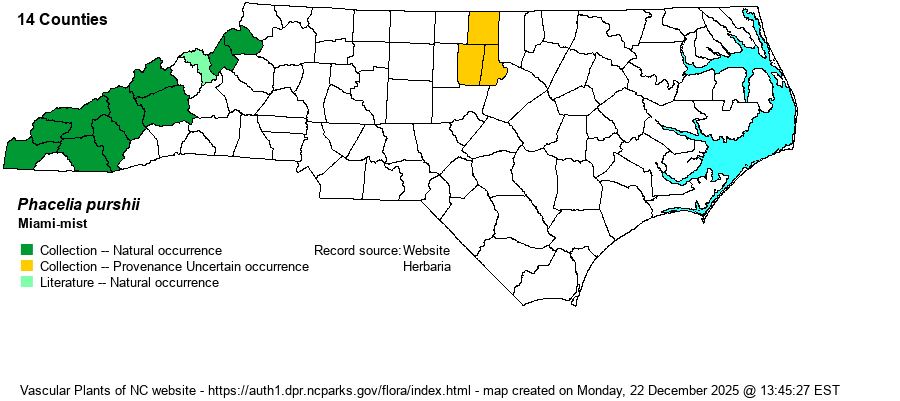| Author | Buckley | |
| Distribution | Present in much of the Mountains, though mostly in the central and southern portions; collections for only 10 of the 17 counties in the province. Also a few collections from the northeastern Piedmont, considered as Provenance Uncertain, as VA has no collection records in its southern Piedmont. Some of the records, including specimens, have not been assigned to variety, and thus this range map includes counties not found on the other two variety maps combined.
This is an Ohio/Tennessee Valley species, with the range mainly west of the Appalachians, but including this range. Occurs from PA and MO south to central GA and AR.
| |
| Abundance | Uncommon to locally infrequent, but can be very numerous at a given site in the Mountains. Essentially absent east of the Mountains, though it could show up in the northern Piedmont, as an uncertain native species. Though NCNHP has its State Rank as S2, it does not have it on its Watch List. The website editors feel that a rank of S2S3 is more appropriate, and keeping it off the Watch List, as this is -- by no means -- a rare species in the NC Mountains. | |
| Habitat | Though this species can occur in rich forests, such as Rich Cove Forests, with or near P. fimbriata, it more often is found growing on rich soil in sun or partial sun, on roadsides, moist meadows, and openings in bottomland forests. Thus, it can appear weedy in the Mountains, and thus where it has been found in the northeastern Piedmont (mostly in wet fields and openings in bottomlands) it is possibly in suitable habitat where it could perhaps be considered as "natural". | |
| Phenology | Blooms later than P. fimbriata by a few weeks, from May into June, and fruits shortly after flowering. | |
| Identification | This is a more robust species than other Phacelia species in the state except for P. bipinnatifida. It grows erect or sprawling, to about 1 foot tall, with branches from the base or strict without branches. This species has different leaves from the other fringed species -- P. fimbriata, with them averaging about 1-1.5 inches long and more deeply and sharply cut into 5-11 pinnate segments, each one tooth-like in shape. At the ends of the branches are the small clusters of cymes, with each flower being about 1/2-inch across. The petals are fringed and are lilac to lavender to pink with white at the base (so that the open flower is white in the middle). Thus, it should be reasonably different from P. fimbriata, even if both grow on the same forested slope, separated by its taller size, longer leaves with more deeply toothed look, and flowers that are lavender or lilac in color. To distinguish from the recently recognized P. purshii var. boykinii, see journal paper by Levy (2021). | |
| Taxonomic Comments | The above account treats the species as a whole. In a 2020 paper by Foster Levy (Levy 2020), he recognizes var. boykinii and var. purshii. He maps the former in Haywood, Madison, and Swain counties; the latter in Jackson, Swain, and Watauga counties. Other counties of occurrence need specimen ID check.
| |
| Other Common Name(s) | Purple Scorpionweed. Though the name "Miami-mist" is certainly an idiosyncratic one, and it would be better to use a "Phacelia" name, this is a long established name with no other alternatives -- and no reference uses Miami-mist Phacelia. | |
| State Rank | S2 [S2S3] | |
| Global Rank | G5 | |
| State Status | | |
| US Status | | |
| USACE-agcp | | |
| USACE-emp | | |

